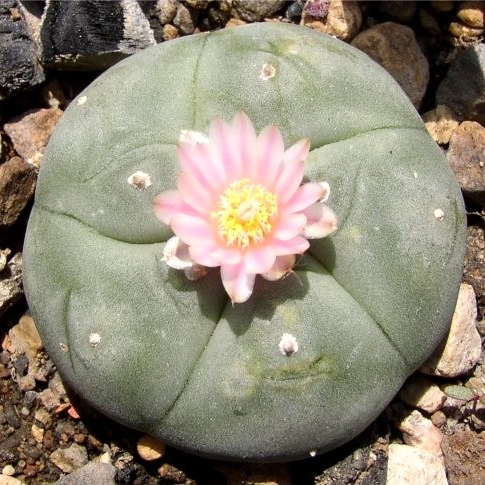PEYOTE
Lophophora williamsii
family: Cactus (Cactaceae)
mata, "cactus"; also word for dried peyote button
Peyote is small, ball-shaped, spineless cactus with grooves in meridional directions. It has long, conical root. Its pink flower grows from the center of the plant. The calyx and crown is not distinguished in color. Peyote grows in the deserts, among shrubs, especially on limestone. It ranges along the Rio Grande River in southern Texas and in the northern and central Mexico, mainly Coahuila, Nuevo León, San Luis Potosí, and Zacatecas States.
Members of some Native American groups cut the central portion of the above-groung part of the plant, and dry it. These sliced and dried above-ground portions are called „mescal buttons“ or peyote, from the Nahuatl (Aztec) word peyōtl, "caterpillar" (Hirschfelder and Molin 1992: peyote), and are used as a drug. Peyote contains many alkaloids with narcotic effects. The most known are mescaline and lophophorine. The chewing of peyote causes visual even acoustic hallucinations, colourful visions, but sometimes depressions. The operation of the drug continues five to six hours, then modulation and physical fatigue come. Long-term use of the drug brings serious insult of liver.
In the late 19th century, the Peyote Religion or Peyote Cult diffused on the Great Plains from the Mexican Native groups. The Southern Cheyennes of Oklahoma met the Peyote Cult about 1885. Among the Northern Cheyennes of Montana, this cult took a root in 1900 (Straus 1976: 43; Stands in Timber 1967: 294, footnote), but Magpie or Leonard Tyler (1866–1913), a Southern Cheyenne, brought peyote to Montana still in 1889 (Weist 1978: 170, footnote; home.epix.net/~landis/tyler.html).
The peyote cult came in the tracks of the Ghost Dance (séotsévȯhomó'hestȯtse). It is influenced by Christianity. In the beginning, the peyote cult met repressions and bans. In 1918, anthropologist James Mooney initiated the Native American Church, the organization arched over the peyote users. First the Oklahoma State licenced it, in 1945, it was legalized on federal level, and a third of US Native Americans is part of the church today (Schukies 1993: 247, 249–50). In Montana, a third of the Northern Cheyennes belonged to the Native American Church in 1922, and ethnologist E. A. Hoebel mentioned 80 percent of the Northern Cheyenne adult population as early as in mid-1930’s (Weist 1978: 170, footnote). Although some Cheyennes protest that the peyote cult is not compatible with traditional religion, and its popularity fell in the last years, the cult is very extended among the reservation communities (Straus 1976: 43–4).
During the year, the peyote cult worshipers hold overnight rituals in tipi. Each tipi is directed by "peyote chief" or "road man." He decides when and where to perform the peyote meeting. Someone, who want the ceremony to cure himself or help his family member, prepares food for all participants, gifts to the road man and his helpers, and other necessary things. The peyote ceremony has no fixed form, but each Cheyenne road man, who are about ten, has own procedures. However, some common elements exist. The ceremonies are held at night. The men even women participate. Fire burns in the tipi, and they will make a large altar in the shape of a crescent moon beside it. The participants sing and pray, a water drum is beated, gourd rattles and fans with feathers of eagle, macaw, hawk, anhinga, flycatcher, and ocellated turkey or soovótanetse ("southern eagle") are used, and people swallow dried peyote buttons to get visions (Moore 1996: 232–4; 1986: 190).
Most frequently, Cheyennnes go into the peyote tipi to look for a help with alcoholism. The peyote meetings are a part of dr. Bernard Albaugh’s program for treatment of alcoholism. This program turned out to be the most effective treatment for the Cheyennes addicted to drink (Moore 1996: 251–2; 291). According to a Cheyenne member of the Native American Church, the participation in the peyote ceremony brings speedy help in early stage of tuberculosis, in fever, stomach ailments, and revmatism (Densmore 1936: 83). Cheyennes described even cases that the peyote ritual cured a cancer patient (Schukies 1993: 101).
Some Cheyennes prepare a tea of dried peyote buttons, called "mátȧhémahpe" (peyote water), which helps in fever for instance. If a man prays, it brings visions (Schukies 1993: 101; Fisher et al. 2012).
> literature
